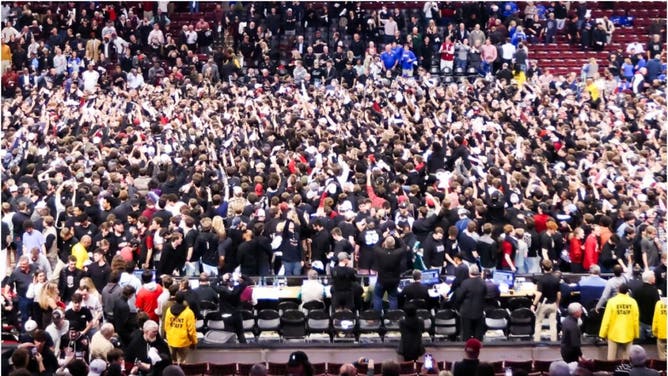Here's An Easy Solution For Court-Storming: Plan For It To Happen | Barrett Sallee
Duke basketball player Kyle Filipowski suffered a leg injury last week when Wake Forest fans stormed the court following the 83-79 win over the Blue Devils. Thankfully, Filipowski’s injury was minor and he returned to the court earlier this week. However, the incident set off a firestorm of takes across the entire country. Fans, local reporters, media members dedicated to college sports and national talking heads all seemed to have an opinion on the matter.
RELATED: Duke's Kyle Filipowski Miraculously Hits The Court After 'Intentional' Hit By Wake Forest Fan
One of the hottest takes centered around the idea of "banning" court and field storming. Newsflash … it’s already banned. That’s why I get an email from the SEC office the Sunday after a fan base leaps from the stands to celebrate on the field after a football upset. It’s why schools send six-figure checks to their conference offices after virtually every instance.

South Carolina students storm the court after beating Kentucky. (Credit: David Jensen/Icon Sportswire via Getty Images)
What are schools supposed to do … put up glass around the field and court of every venue as if all of them were hockey rinks? That’s ridiculous … and yet it seems like it’s the only way to implement the "banning" of court and field-storming.
The easy solution to this "issue" is to simply allow it after a predetermined period of time expires and opposing players and coaches have left the field. Game operations managers can put a timer on the scoreboard so everybody knows when they can celebrate responsibly.
Clemson lets its fans on the field after every football game to "gather at the paw," referencing the school’s logo on the 50-yard line. The Gathering at the Paw, which was officially allowed in 2002 after being more of an unofficial tradition for 80 years, is encouraged to the point where the school has specific rules for entry to the field.
It really is that easy.
Schools can easily set rules beforehand, remind fans during the game over the public address system and mandate security guards – some of whom are contracted through private companies – to go over rules with fans if they feel a court or field-storming event could be in the works.
Fans are receptive to rules as long as they are laid out beforehand.
The SEC nearly banned cowbells from Mississippi State’s Davis Wade Stadium in the mid-2010s. However, the conference and school agreed to embark on a "ring responsibly" campaign that allows fans to ring the cowbells until the opponent approaches the line of scrimmage. It worked. When you attend a game in Starkville, it sounds like a swarm of bees suddenly dies right before the snap.
I’ve been on the field as fans poured onto the playing surface multiple times. I walked to the field-level media center at Jordan-Hare Stadium in Auburn following the "Kick Six" in 2013 hunched over after getting elbowed in the ribs by what felt like every student in the student section. There’s no doubt that it’s dangerous. However, it’s only dangerous because it is a spur-of-the-moment event rather than an event with a predetermined structure in place.
Normalize field and court-storming. It’ll make things a lot easier and safer for everybody involved.